Print runs of the Monclova issue
As stated earlier, in his informe to Congress in 1917 Carranza said that there were five million pesos in the Monclova issueInforme of Carranza, 15 April 1915 as specified in the original decree. In his letter of 14 May 1913AIF, RM/II. I-015 Carranza, Piedras Negras, 14 May 1913 he said that the five million should be distributed as follows:
| Series | total | total value | |
|---|---|---|---|
| $1 | A | 1,000,000 | $1,000,000 |
| $5 | B | 200,000 | 1,000,000 |
| $10 | C | 100,000 | 1,000,000 |
| $20 | D | 50,000 | 1,000,000 |
| $50 | E | 10,000 | 500,000 |
| $100 | F | 5,000 | 500,000 |
| $5,000,000 |
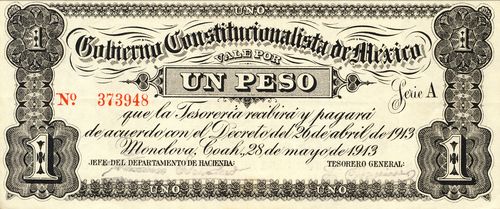 M975a $1 Gobierno Constitucionalista de México
M975a $1 Gobierno Constitucionalista de México
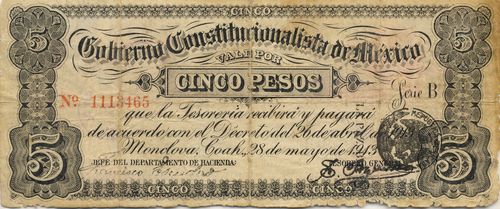 M976a $5 Gobierno Constitucionalista de México
M976a $5 Gobierno Constitucionalista de México
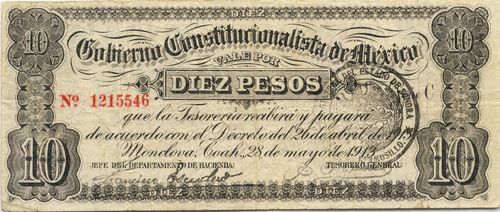 M977a $10 Gobierno Constitucionalista de México
M977a $10 Gobierno Constitucionalista de México
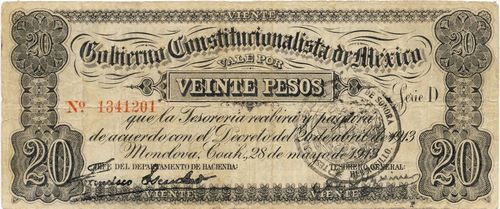
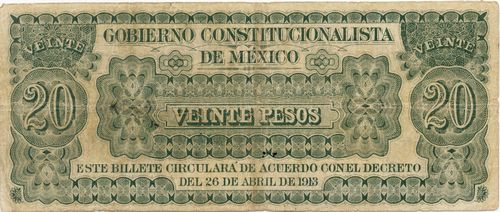 M978a $20 Gobierno Constitucionalista de México
M978a $20 Gobierno Constitucionalista de México
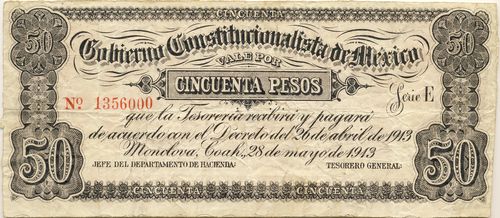
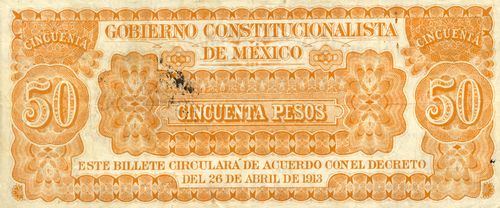 M979a $50 Gobierno Constitucionalista de México
M979a $50 Gobierno Constitucionalista de México
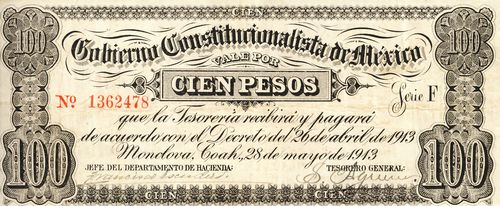
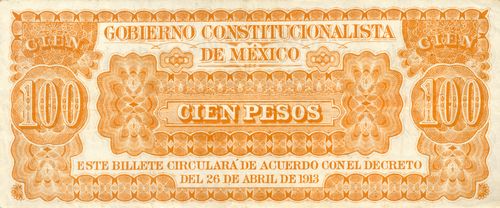 M980a $100 Gobierno Constitucionalista de México
M980a $100 Gobierno Constitucionalista de México
| series | from | to | total number |
total value |
||
| $1 | A | 999999 | 1,000,000 | $1,000,000 | stamped signatures includes numbers 82374 to 900569 |
|
| $5 | B | 1000001 | 1200000 |
200,000 | 1,000,000 | |
| $10 | C | 1200001 |
1300000 |
100,000 | 1,000.000 | |
| $20 | D | 1300001 |
50,000 | 1,000,000 | ||
| 1350000 |
||||||
| $50 | E | 1350001 | 1360000 | 10,000 | 500,000 | includes number 1350487CNBanxico #10146 to 1360000 |
| $100 | F | 1360001 | 1365000 | 5,000 | 500,000 | includes number 1361357CNBanxico #10149 to 1363357CNBanxico #59 |
| 1,165,000 | $5,000,000 |
On 11 January 1914 Carranza was writing to Robert V. Pesqueira in Washington to discuss another issue of $15,000,000CEHM, Fondo MVIII telegram Carranza, Navojoa to Pesqueira, Washington, 11 January 1914. On 14 January he told Rafael Zubarán to ask Heriberto Barron to ask a Los Angeles printing house for the price of printing $25,000,000 in notesCEHM, Fondo MVIII telegram Carranza, Navojoa to Zubarán, Hermosillo, 14 January 1914; telegram Zubarán, Hermosillo, to Barron, Los Angeles,14 January 1914. On the same day he wrote to Pesqueira in Washington about an issue, but unfortunately in codeCEHM, Fondo MVIII telegram Carranza, Navojoa to Pesqueira, Washington, 14 January 1914. However, this new issue was to be as followsCEHM, Fondo XXI-4 and Fondo MVIII telegram Carranza to Zubarán (and since it included $50 and $100 denominations must be Monclova notes):
| total | total value | |
|---|---|---|
| $1 | 10,000,000 | $10,000,000 |
| $5 | 1,000,000 | 5,000,000 |
| $10 | 400,000 | 4,000,000 |
| $20 | 100,000 | 2,000,000 |
| $50 | 40,000 | 2,000,000 |
| $100 | 20,000 | 2,000,000 |
| $25,000,000 |
On 22 January Serapio Aguirre, Carranza's Tesorero General de la Federación wrote to the Secretario del Gobierno in Hermosillo asking him to commission someone who, with the oversight of someone from Aguirre’s office, would print facsimile signatures on to the Gobierno Constitucionalista de México notes, that would Aguirre would be sendingAGHES, Fondo Oficialidad Mayor, tomo 2993, letter Aguirre, 22 Jauary 1914. A handwritten note says the letter should be shown to a Sr. Monteverde. On 29 January the governor passed the request on to the Director of the government printing press AGHES, Fondo Oficialidad Mayor, tomo 2993 Oficial Primero, Hermosillo, to Director de la Imprenta del Gobierno del Estado, Hermosillo, 29 January 1914.
On 23 January Carranza, sent a telegram to Pesqueira that he was surprised that to date he had received less than half of the five million in notes. Moreover, Pesqueira and Cabrera had not given any information to him about the new issue of 15 million, made with the same clichés and changing just the date and place of issue. Pesqueira was to apply himself exclusively to that taskCEHM, Fondo MVIII telegram Carranza, Culiacán to Roberto V. Pesqueira, Washington, 23 January 1914. At the end of January, Carranza told Zubarán that it was not convenient to have the printing done in Los Angeles, so leaving the matter in Pesqueira’s handsCEHM, Fondo MVIII. So it is likely that the second issue was printed in Washington.
In agreement with this version the standard catalogue, Mexican Paper Money, identifies two issues and believes both to be genuine. It states that “the early issue of the 5, 10 and 20 peso notes, aside from having lower serial numbers than the late series, bears a much lower quality engraving. The logical improvement in engraving came with the later series. The denomination in letters, which appears on the back of the 5, 10, and 20 peso notes is much larger on the late series than on the early series. It would be illogical to suppose that a counterfeiter would make such a radical change in design on all denominations".
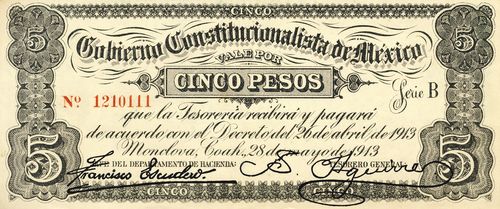
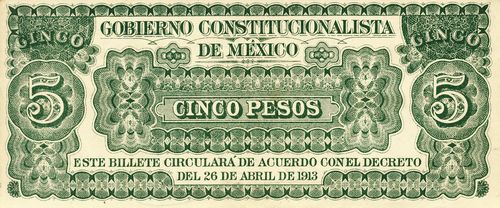 M976b $5 Gobierno Constitucionalista de México
M976b $5 Gobierno Constitucionalista de México
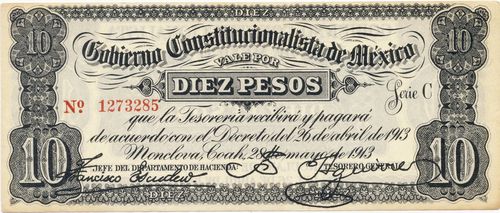
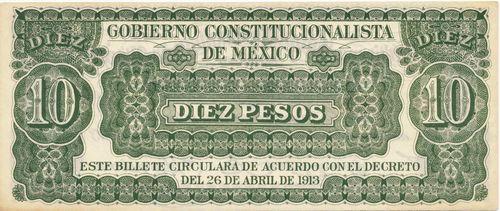 M977b $10 Gobierno Constitucionalista de México
M977b $10 Gobierno Constitucionalista de México
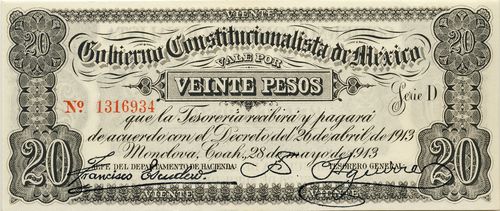
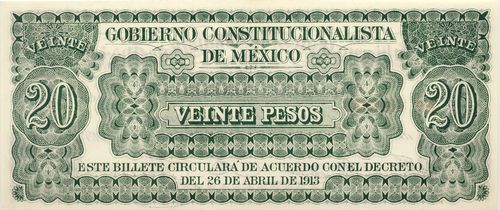 M978b $20 Gobierno Constitucionalista de México
M978b $20 Gobierno Constitucionalista de México
| series | from | to | total number |
total value |
||
| $1 | A | |||||
| $5 | B | large printed signatures includes number 1037511 to 1136187 |
||||
| $10 | C | large printed signatures includes number 1213109 to 1331523 |
||||
| $20 | D | large printed signatures includes number 1316934 to |
||||
| $50 | E | |||||
| $100 | F | |||||
However, this is too simplistic. The signatures appear to differ not only in size but as handsigned, stamped and also printed. Contemporary accounts refers to signatures being handsigned, rubberstamped and lithographedOn 7 February 1914 the Prefecto of Cumpas wrote that he had a $50 note with Escudero’s signature in facsimile. He wanted to know if notes greater than $10 with facsimiles were good (AGHES, Fondo Oficialidad Mayor, tomo 2993 telegram Prefecto, Cumpas, 7 February 1914). Maytorena passed the query on to Carranza’s Secretaría de Hacienda in Nogales (AGHES, Fondo Oficialidad Mayor, tomo 2993 telegram Maytorena, Hermosillo to Esquerro, Oficial Mayor encargado de despacho de la Secretaría de Hacienda, Nogales, 10 February 1914) who replied that notes up to the $20 value had two facsimile signatures whilst higher valued had a facsimile of Escudero and an actual signature of Aguirre (AGHES, Fondo Oficialidad Mayor, tomo 2993 telegram Esquerro, Nogales, to Maytorena, Hermosillo, 10 February 1914).
On 11 February the Dirección General de Timbre in Durango reported to the government that $1 and $5 Monclova notes with manuscript signatures had appeared and that Carranza had ordered them to be collected as the genuine notes had stamped signatures. The message was passed on to the oficinas de Hacienda (ADUR, Libro Copiador 267, Hacienda 11 July 1913 - 25 April 1914, p794 and p795):

no signatures

handsigned, handsigned

small printed signatures


stamped, stamped



large printed signatures
However, considering that
- a major difference is in the signatures which were not originally printed on the notes but hand-signed or stamped (and there is not a clean break between lower serial numbers and smaller signatures and higher serial numbers and larger (and printed) signatures;
- the $1 notes have only six-digit serial numbers (which implies a maximum of 999,999 notes before some alternative sequencing arrangement is necessary, and the higher values, though they have seven digits, are known in only limited ranges of numbers
is it heretical to suggest that
- Carranza was correct when he stated that the Monclova issue was for five million pesos;
- despite Zubarán and Pesqueira's efforts another issue never materialised (their efforts being overtaken by the Ejército Constitucionalista notes, and consequently
- most notes are counterfeit?
Again, whilst acknowledging that there are such obvious differences in design and the manner of applying the signatures, which seem to imply different print runs, is it possible to distinguish between legitimate printing and the various counterfeits, particularly since many of the counterfeits were stated to be such excellent copies?
